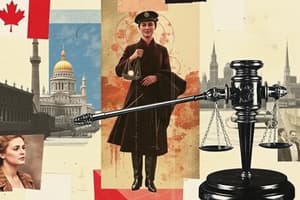Podcast
Questions and Answers
What is law?
What is law?
A formally enacted or customary body of rules recognized as binding on people within a state or a community.
What is positive law?
What is positive law?
- Law is whatever judges say it is.
- Law based on moral, religious or philosophical grounds.
- Law created by a person or body with the authority to enact and enforce it. (correct)
What is Natural Law?
What is Natural Law?
- Law is whatever judges say it is.
- Law created by a person or body with the authority to enact and enforce it.
- Law based on moral, religious or philosophical grounds. (correct)
What best describes legal realism?
What best describes legal realism?
Which of the following is a purpose of law?
Which of the following is a purpose of law?
Which of the following is a division of law?
Which of the following is a division of law?
What is public law associated with?
What is public law associated with?
What is private law associated with?
What is private law associated with?
What is the purpose of criminal law?
What is the purpose of criminal law?
What resolution does civil law provide?
What resolution does civil law provide?
What are the rights and remedies?
What are the rights and remedies?
The procedures through which substantive rights are protected is?
The procedures through which substantive rights are protected is?
Arrange the Canadian Governmental Hierarchy in order:
Arrange the Canadian Governmental Hierarchy in order:
What are the sources of Canadian Law?
What are the sources of Canadian Law?
Which of the following is part of the Federal Courts?
Which of the following is part of the Federal Courts?
The Superior Courts of the Province uses what judges?
The Superior Courts of the Province uses what judges?
What judges are appointed to Provincial Courts?
What judges are appointed to Provincial Courts?
Plaintiff responds with reply or statement of defence to the counterclaim?
Plaintiff responds with reply or statement of defence to the counterclaim?
Appeals of civil cases are granted automatically?
Appeals of civil cases are granted automatically?
What happens when a party refuses a reasonable offer?
What happens when a party refuses a reasonable offer?
According to the Canadian Charter of Rights and Freedoms, what evidence is inadmissible?
According to the Canadian Charter of Rights and Freedoms, what evidence is inadmissible?
What are the types of offenses in criminal procedure?
What are the types of offenses in criminal procedure?
In criminal procedure, what must the Crown prove?
In criminal procedure, what must the Crown prove?
The first step in criminal court procedure is arraignment.
The first step in criminal court procedure is arraignment.
Flashcards
Law
Law
A formally enacted or customary body of rules recognized as binding within a state or community.
Positive Law
Positive Law
Law created by an authority figure.
Natural Law
Natural Law
Law based on moral, religious, or philosophical grounds.
Legal Realism
Legal Realism
Signup and view all the flashcards
Purposes of Law
Purposes of Law
Signup and view all the flashcards
Public Law
Public Law
Signup and view all the flashcards
Private Law
Private Law
Signup and view all the flashcards
Criminal Law
Criminal Law
Signup and view all the flashcards
Civil Law
Civil Law
Signup and view all the flashcards
Substantive Law
Substantive Law
Signup and view all the flashcards
Procedural Law
Procedural Law
Signup and view all the flashcards
Canadian Governmental Hierarchy
Canadian Governmental Hierarchy
Signup and view all the flashcards
Legislators
Legislators
Signup and view all the flashcards
Judges
Judges
Signup and view all the flashcards
Jurors
Jurors
Signup and view all the flashcards
Lawyers
Lawyers
Signup and view all the flashcards
Sources of Canadian Law
Sources of Canadian Law
Signup and view all the flashcards
Supreme Court of Canada
Supreme Court of Canada
Signup and view all the flashcards
Federal Court of Canada
Federal Court of Canada
Signup and view all the flashcards
Other Federal Courts
Other Federal Courts
Signup and view all the flashcards
Superior Courts of the Province
Superior Courts of the Province
Signup and view all the flashcards
Provincial Courts
Provincial Courts
Signup and view all the flashcards
Provincial Boards, Commissions, and Tribunals
Provincial Boards, Commissions, and Tribunals
Signup and view all the flashcards
Civil Court Procedure Stages
Civil Court Procedure Stages
Signup and view all the flashcards
Pleadings (Civil)
Pleadings (Civil)
Signup and view all the flashcards
Discoveries (Civil)
Discoveries (Civil)
Signup and view all the flashcards
Pretrial or Mediation
Pretrial or Mediation
Signup and view all the flashcards
Trial (Civil)
Trial (Civil)
Signup and view all the flashcards
Appeals (Civil)
Appeals (Civil)
Signup and view all the flashcards
Types of Criminal Offences in Canada
Types of Criminal Offences in Canada
Signup and view all the flashcards
Study Notes
The Canadian Legal System
- This chapter provides the historical background to Canadian law
- This chapter identifies sources of Canadian law
- This chapter introduces the concept of legal jurisdiction
- This chapter compares and contrasts criminal and civil legal procedures
What is Law?
- A formally enacted or customary body of rules recognized as binding on people within a state/community
- Enforcement of rules is part of the design in an organized society
Purposes of Law
- Maintain the integrity of state boundaries
- Maintain law and order
- Protect citizens from each other and abuse of power by officials
- It is designed to provide forum for dispute resolution between citizens or between citizens and government
- It establishes and maintains standards relating to areas such as health, education and employment
Theoretical Bases of Law
- Positive Law is law created by a person or body with authority to enact and enforce it
- Natural Law means law based on moral, religious or philosophical grounds
- Legal Realism means law is whatever judges say it is
Divisions of Law
- Public law is associated with government and the public interest
- Private law is associated with interpersonal matters
- Criminal law seeks to provide protection of the political security of the state and its citizens
- Civil law seeks to provide non-criminal resolution of disputes
- Substantive law relates to rights and remedies
- Procedural law relates to the procedures through which substantive rights are protected
Canadian Governmental Hierarchy
- The sovereign, Queen Elizabeth II
- Federal parliament (House of Commons and Senate)
- Provincial or territorial legislatures
- Municipal governments
Players in the Legal System
- Legislators are elected
- Judges are appointed
- Jurors are chosen from citizens who have no criminal convictions
- Lawyers must be "called to the bar" and have a law degree
- Clients
- Police
Sources of Canadian Law
- Royal prerogatives are a source of Canadian Law
- Legislative enactments
- Delegated lawmaking
- Judge-made law
Federal Courts
- Supreme Court of Canada has nine federally appointed justices with jurisdiction to hear all criminal, civil and constitutional cases
- Federal Court of Canada has trial and appeal divisions with jurisdiction to hear cases on patents, copyright, trademark, aeronautics, maritime law, interprovincial and federal-provincial disputes
- Tax Court of Canada
- Court Martial Appeal Court of Canada deals with military matters
- Court of Canadian Citizenship
Provincial Courts
- Superior Courts of the Province have federally appointed judges with jurisdiction to hear indictable offence cases like murder/ treason
- They also hear divorce cases, civil cases above the ceiling for small claims, and admin law applications from boards and tribunals
- Provincial Courts have provincially appointed judges with jurisdiction to hear less serious Criminal Code offences
- Also to hear support and custody applications in family law, youth court issues and small claims cases
- Provincial Boards, Commissions and Tribunals jurisdiction includes liquor licensing, employment standards and labour relations
Civil Court Procedure
- There are 5 stages: Pleadings, Discoveries, Pre-trial or mediation, Trial, Appeal
Civil Court Procedure Stages
- Pleadings involve the plaintiff filing a statement of claim that is personally served on defendant
- The defendant responds with a statement of defence
- The defendant may also counterclaim against the plaintiff and crossclaim against co-defendant
- Defendant can bring third party claim against someone not a party to the lawsuit
- The plaintiff responds with reply or statement of defence to the counterclaim
- Discoveries seek to identify all facts, issues and evidence prior to trial
- Each party examines the other under oath
- A certified reporter records the questions and answers and prepares a transcript of them
- Parties must list all documents relevant to the case and the names of witnesses to be called
- Pretrial or mediation is intended to facilitate settlement or reduce issues at trial
- If a pretrial occurs, that judge is disqualified from proceeding at the actual trial
- In some provinces/territories, mediation is mandatory
- The plaintiff makes opening statement and presents case at trial
- Plaintiff's witnesses are examined in chief, and cross-examined by the defendant
- The defendant presents defence in chief, and plaintiff cross-examines
- The plaintiff must prove case on a balance of probabilities
- Appeals of civil cases are not granted automatically
- Appeals are usually limited to errors of law, and not of fact
Civil Court: Offers to Settle, Costs, and Enforcement
- Parties are encouraged to settle out of court before trial
- A party who refuses a reasonable offer may be punished by the court and pay the court costs of the other litigant
- Garnishment of wages and seizure and sale of the losing litigant's assets by a sheriff may assist the winning litigant in judgment
Civil Court: Evidence
- Rules of procedure require that evidence gathered that infringes rights guaranteed under the Canadian Charter of Rights and Freedoms is inadmissible
Criminal Procedure
- Designed to protect against acts that threaten the security of a person or the state
- Types of offences: summary conviction (minor), indictable (serious), and hybrid
- In hybrid offences the Crown can proceed summarily or by indictment
- The Crown must prove its case beyond a reasonable doubt.
Criminal Procedure Stage
- First step is arraignment If plea is "not guilty,” the case proceeds to trial
- The accused may choose trial by jury or by judge alone
- Crown calls prosecution's witnesses and examines in chief
- Defence may cross-examine
- If Crown does not meet the burden of proof, the presumption of innocence applies
Studying That Suits You
Use AI to generate personalized quizzes and flashcards to suit your learning preferences.




